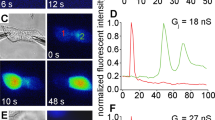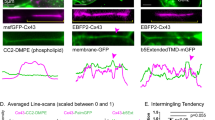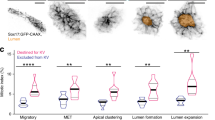Abstract
Antibodies to the major protein of rat liver gap junctions, molecular weight 27,000 (27K), have been microinjected into one identified cell of 8-cell stage Xenopus embryos. This treatment selectively disrupts both dye transfer and electrical coupling between the progeny cells. These results provide evidence that the 27K protein is an integral component of the cell-to-cell junctional channel. The disruption of junctional communication at early stages results in specific developmental defects, suggesting that blocking intercellular communication can have a pronounced influence on embryonic development.
This is a preview of subscription content, access via your institution
Access options
Subscribe to this journal
Receive 51 print issues and online access
$199.00 per year
only $3.90 per issue
Buy this article
- Purchase on Springer Link
- Instant access to full article PDF
Prices may be subject to local taxes which are calculated during checkout
Similar content being viewed by others
References
Gilula, N. B., Reeves, O. R. & Steinbach, A. Nature 235, 262–265 (1972).
Spray, D. C., Harris, A. L. & Bennett, M. V. L. in Cellular Communication During Ocular Development (eds Sheffield, J. B. & Hilfer, S. R.) 57–84 (Springer, New York, 1982).
Potter, D. D., Furshpan, E. J. & Lennox, E. Proc. natn. Acad. Sci. U.S.A. 55, 328–336 (1966).
Rose, B. & Loewenstein, W. R. J. Membrane Biol. 28, 87–119 (1976).
Turin, L. & Warner, A. E. J. Physiol., Lond. 300, 489–504 (1980).
Johnston, M. F., Simon, S. A. & Ramon, F. Nature 286, 498–500 (1980).
Henderson, D., Eibl, H. & Weber, K. J. molec. Biol. 132, 193–218 (1979).
Hertzberg, E. L. & Gilula, N. B. J. biol. Chem. 254, 2138–2147 (1979).
Hertzberg, E. L. J. biol. Chem. 259, 9936–9943 (1984).
Epstein, M. L., Sheridan, J. D. & Johnson, R. G. Expl Cell Res. 104, 25–30 (1977).
Newport, J. & Kirschner, M. Cell 30, 675–686 (1982).
Lee, G., Hynes, R., Kirschner, M. Cell 36, 729–740 (1984).
Slack, C., Warner, A. E. & Warren, R. L. J. Physiol., Lond. 232, 297–312 (1973).
Guthrie, S. C. Nature 310, 149–151 (1984).
Rink, T. J., Tsien, R. Y. & Warner, A. E. Nature 283, 658–660 (1980).
Porter, R. R. Biochem. J. 73, 119–126 (1959).
Slemmon, J. R., Salvaterra, P. M. & Saito, K. J. Histochem. Cytochem. 28, 10–15 (1980).
Epstein, M. L. & Gilula, N. B. J. Cell Biol. 75, 769–787 (1977).
Makowski, L., Caspar, D. L. D., Phillips, W. C. & Goodenough, D. A. J. Cell Biol. 74, 629–645 (1977).
Unwin, P. N. T. & Zampighi, G. Nature 283, 545–549 (1980).
Parikh, I., March, S. & Cuatrecasas, P. Meth. Enzym. 346, 77–102 (1974).
Laemmli, U. K. Nature 227, 680–695 (1970).
Towbin, H., Staehelin, T. & Gordon, J. Proc. natn. Acad. Sci. U.S.A. 76, 4350–4354 (1979).
Nieuwkoop, P. D. & Faber, J. Normal Table of Xenopus laevis (Davdin) (North-Holland, Amsterdam, 1956).
Author information
Authors and Affiliations
Rights and permissions
About this article
Cite this article
Warner, A., Guthrie, S. & Gilula, N. Antibodies to gap-junctional protein selectively disrupt junctional communication in the early amphibian embryo. Nature 311, 127–131 (1984). https://doi.org/10.1038/311127a0
Received:
Accepted:
Issue Date:
DOI: https://doi.org/10.1038/311127a0
This article is cited by
-
Establishment and functional characterization of a murine primary Sertoli cell line deficient of connexin43
Cell and Tissue Research (2020)
-
Acetylation of C-terminal lysines modulates protein turnover and stability of Connexin-32
BMC Cell Biology (2018)
-
Connexins and pannexins in neuronal development and adult neurogenesis
BMC Cell Biology (2016)
-
Cell-to-cell communication in plants, animals, and fungi: a comparative review
Naturwissenschaften (2013)
Comments
By submitting a comment you agree to abide by our Terms and Community Guidelines. If you find something abusive or that does not comply with our terms or guidelines please flag it as inappropriate.



